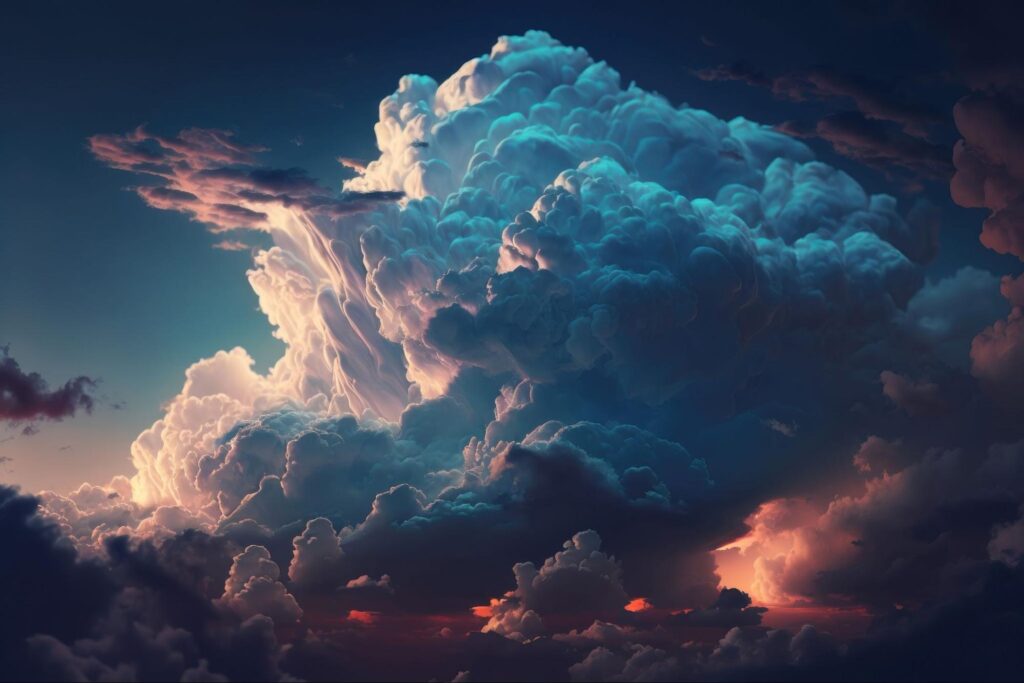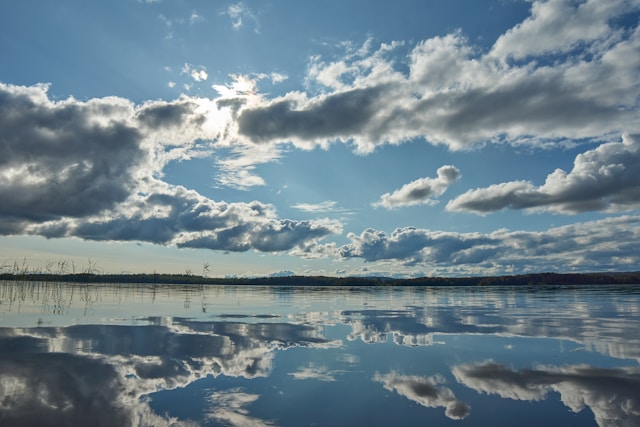The vast expanse of the sky is adorned with ever-changing clouds, painting mesmerizing scenes above us. These ethereal wonders have sparked the imagination of artists, writers, and dreamers throughout history. Clouds not only add beauty to our skies but also play a vital role in our planet’s weather systems.
In this article, we will delve into the fascinating world of clouds, uncovering their formation, classification, unique phenomena, and even their cultural significance in film and literature. Prepare to embark on a captivating journey through the heavens as we unravel the secrets of clouds.
Key Facts about Clouds
Cloud Formation: Clouds form when warm, moist air rises, expands, and cools, causing water vapor to condense around microscopic particles known as cloud condensation nuclei. This condensation leads to the formation of tiny water droplets or ice crystals.
Types of Clouds
Clouds are classified into four main types based on their appearance and altitude:
- Cumulus clouds are fluffy and white. They have a flat base and are typically found at low altitudes;
- Stratus clouds are uniform and layered, covering large areas of the sky;
- Cirrus clouds are thin, wispy, and found at high altitudes, resembling delicate brushstrokes;
- Cumulonimbus clouds are towering, vertically developed clouds associated with thunderstorms and heavy precipitation.
Altitude Classification
Clouds are further categorized into three altitude levels: low clouds, forming below 6,500 feet (2,000 meters); middle clouds, forming between 6,500 and 20,000 feet (2,000 to 6,000 meters); and high clouds, forming above 20,000 feet (6,000 meters).
Striking Shapes and Phenomena
Clouds exhibit a remarkable variety of shapes and formations. Lenticular clouds resemble flying saucers and often appear near mountains. Mammatus clouds are pouch-like structures hanging beneath the base of thunderstorm clouds. The mesmerizing colors of iridescent clouds are caused by the diffraction of sunlight passing through tiny water droplets or ice crystals.
Atmospheric Influences
Various atmospheric conditions impact cloud formation. Orographic clouds form when moist air is lifted by topographic barriers, such as mountains, resulting in clouds forming on the windward side. Fog, a cloud that forms at the Earth’s surface, occurs when warm, moist air comes into contact with cooler surfaces, causing water vapor to condense.
Cloud Seeding
Scientists have experimented with cloud seeding, a process of dispersing substances into clouds to enhance precipitation or suppress hail formation. Silver iodide and dry ice are commonly used as cloud-seeding agents, aiming to encourage the formation of ice crystals within clouds.
Unraveling Cloud Formation
Clouds form through a complex interplay of temperature, humidity, and atmospheric conditions. Understanding the science behind cloud formation is key to appreciating these stunning natural phenomena. The process begins with warm, moist air rising into the cooler upper atmosphere.
As the air ascends, it expands, cools, and reaches its dew point, causing the water vapor to condense around cloud condensation nuclei. The resulting tiny water droplets or ice crystals form the building blocks of clouds.
Interesting Fact: The height of clouds can vary greatly, with some high-altitude clouds reaching heights of 40,000 to 60,000 feet (12,000 to 18,000 meters).

A Closer Look at Cloud Types
Clouds come in various shapes, sizes, and altitudes. By categorizing clouds based on their characteristics, meteorologists can decipher atmospheric conditions and forecast weather patterns.
Let’s explore the four main types of clouds in detail.
- Cumulus Clouds: These are the fluffy, white clouds with a flat base commonly seen on sunny days. They often resemble cotton balls and can appear in various shapes, including cumulus humilis (small and harmless) or cumulus congestus (larger and more vertically developed), which can evolve into cumulonimbus clouds;
- Stratus Clouds: These are low-altitude, uniform, and layered clouds that cover large areas of the sky, creating a gray or overcast appearance. Stratus clouds often bring drizzle or steady rain and can sometimes form fog when they reach the ground;
- Cirrus Clouds: Cirrus clouds are high-altitude clouds composed of ice crystals. They have a wispy, feathery appearance and often stretch across the sky in delicate streaks. Cirrus clouds are commonly associated with fair weather but can indicate approaching changes in atmospheric conditions;
- Cumulonimbus Clouds: These towering, vertically developed clouds are often associated with thunderstorms, heavy rainfall, lightning, and sometimes hail. They exhibit a distinctive anvil shape at their upper levels, caused by the strong upper-level winds that flatten the cloud top.
Interesting Fact: The Latin word “cumulus” means “heap” or “pile,” which accurately describes the fluffy, piled-up appearance of cumulus clouds.
Altitude Matters: Classifying Clouds by Height
Clouds not only differ in appearance but also in their vertical placement within the atmosphere. By classifying clouds based on altitude, we can gain insights into the different atmospheric layers and their respective cloud formations:
- Low Clouds: Low clouds form below 6,500 feet (2,000 meters) and include clouds with the prefix “strato” and “cumulo.” Examples of low clouds include stratus, stratocumulus, and cumulus clouds. These clouds often bring drizzle, light rain, or localized showers;
- Middle Clouds: Middle clouds form between 6,500 and 20,000 feet (2,000 to 6,000 meters). Clouds with the prefix “alto” belong to this category. Altostratus and altocumulus clouds are common middle-level clouds, indicating the presence of moisture in the atmosphere;
- High Clouds: High clouds form above 20,000 feet (6,000 meters) and include clouds with the prefix “cirro.” Cirrus, cirrostratus, and cirrocumulus clouds are found in the upper reaches of the troposphere. These delicate clouds are composed of ice crystals and often indicate stable atmospheric conditions.
Interesting Fact: Noctilucent clouds, also known as polar mesospheric clouds, are the highest clouds in Earth’s atmosphere, forming around 50 miles (80 kilometers) above the Earth’s surface in the mesosphere. They are typically seen at high latitudes during the summer months and glow with a mesmerizing blue or silver hue.
Nature’s Artistry: Unique Cloud Shapes and Phenomena
Clouds are nature’s canvas, constantly painting the sky with an array of captivating shapes and phenomena. Let’s explore some of the extraordinary cloud formations that capture our imagination.
Lenticular Clouds
Lenticular clouds are lens-shaped formations that often resemble flying saucers or stacks of pancakes. They typically form near mountain ranges where moist air is forced upward by the terrain. The air cools, condenses, and forms these distinctive cloud structures.
Mammatus Clouds
Mammatus clouds are characterized by their pouch-like structures hanging beneath the base of thunderstorm clouds. These formations are caused by sinking pockets of cool air, indicating turbulent atmospheric conditions. Mammatus clouds create a surreal and dramatic appearance in the sky.
Iridescent Clouds
Iridescent clouds, also known as rainbow clouds, are a stunning display of colors seen within clouds. They occur when sunlight passes through water droplets or ice crystals, causing diffraction and creating a beautiful spectrum of hues. Iridescent clouds are rare and are often observed in altocumulus, cirrocumulus, or lenticular clouds.
Pileus Clouds
Pileus clouds, also called cap clouds, form as a smooth, cap-like cloud above a rapidly growing cumulus cloud. They indicate strong updrafts and can be seen as a precursor to the development of cumulonimbus clouds and thunderstorms.
Interesting Fact: Cloud streets are long, parallel bands of cumulus clouds that resemble streets or rows in the sky. They form when air flows in parallel to the Earth’s surface and encounters a boundary, such as a cold front or a change in surface temperature.

Beyond the Clouds: Atmospheric Influences and Fog Formation
Clouds are deeply interconnected with the surrounding atmospheric conditions. Let’s explore how various factors influence cloud formation and the intriguing phenomenon of fog:
- Orographic Clouds: Orographic clouds are formed when moist air is forced to rise over topographic barriers, such as mountains. As the air ascends, it cools and forms clouds on the windward side of the mountain. The resulting clouds can create breathtaking scenes as they envelop the peaks and slopes;
- Fog Formation: Fog is essentially a cloud that forms at or near the Earth’s surface. It occurs when warm, moist air comes into contact with cooler surfaces, causing the water vapor to condense into tiny water droplets. Fog can develop in various ways, including radiation fog (forming overnight due to cooling of the surface), advection fog (caused by the movement of moist air over a colder surface), and upslope fog (resulting from moist air rising along a slope).
Interesting Fact: The city of San Francisco is famous for its iconic fog, affectionately known as “Karl” by the locals. The cool, marine layer frequently rolls in from the Pacific Ocean, engulfing the city and creating a mystical atmosphere.
Enhancing Precipitation: The Science of Cloud Seeding
In our quest to understand and manage weather patterns, scientists have explored the concept of cloud seeding. This process involves the deliberate introduction of substances into clouds to influence their properties and enhance precipitation.
- Cloud Seeding Techniques: Various methods of cloud seeding have been employed, typically using silver iodide or dry ice as seeding agents. These substances promote the formation of ice crystals within clouds, which can lead to increased rainfall or snowfall. Cloud seeding has been used in regions facing water scarcity or to mitigate the damage caused by hailstorms;
- Effectiveness and Controversies: The effectiveness of cloud seeding is still a subject of scientific debate. While some studies have shown positive results in increasing rainfall, others have found inconclusive evidence. Additionally, concerns regarding potential environmental impacts and unintended consequences continue to be discussed.
Interesting Fact: Cloud seeding was famously employed during the 2008 Beijing Olympics to ensure clear skies and minimize rainfall during the opening and closing ceremonies. The Chinese government launched a massive cloud-seeding operation to prevent rain from interfering with the events.
Clouds in Film and Literature
Clouds have not only fascinated scientists but have also found their place in the realms of art, film, and literature. Their symbolic nature and aesthetic appeal have made them powerful metaphors and captivating visual elements in storytelling:
Clouds in Film
Clouds often play significant roles in creating atmospheric settings in films. They can symbolize hope, mystery, or impending doom, adding depth to cinematic narratives. From the swirling tornadoes in “The Wizard of Oz” to the dreamlike cloudscape in “The NeverEnding Story,” clouds contribute to the visual language of storytelling.
Clouds in Literature
Writers have long been inspired by the evocative nature of clouds. From the ethereal landscapes depicted in the poetry of William Wordsworth to the symbolic clouds in Antoine de Saint-Exupéry’s “The Little Prince,” clouds have been woven into the fabric of literary works, providing a rich tapestry of symbolism and imagination.
Interesting Fact: The Cloud Appreciation Society, founded by Gavin Pretor-Pinney, celebrates the beauty and science of clouds. With thousands of members worldwide, the society encourages people to explore the wonders of clouds and share their cloud-related experiences and photographs.
Key Facts about Clouds
| Fact | Description |
|---|---|
| Cloud Formation | Warm, moist air rises, expands, and cools, causing condensation around cloud condensation nuclei. |
| Types of Clouds | Cumulus, stratus, cirrus, cumulonimbus |
| Altitude Classification | Low clouds (<6,500 ft), middle clouds (6,500-20,000 ft), high clouds (>20,000 ft) |
| Unique Cloud Shapes and Phenomena | Lenticular clouds, Mammatus clouds, iridescent clouds |
| Atmospheric Influences | Orographic clouds, fog formation |
| Cloud Seeding | Techniques, effectiveness, controversies |
| Clouds in Film and Literature | Symbolism, visual storytelling |
Conclusion
Clouds, with their ever-changing forms and mesmerizing displays, have captured our imagination for centuries. They are not only a source of awe and inspiration but also crucial components of Earth’s climate system.
By understanding the science behind cloud formation, classification, atmospheric influences, and even their portrayal in film and literature, we gain a deeper appreciation for these enchanting natural wonders that grace our skies. So, the next time you find yourself gazing upward, take a moment to marvel at the intricacies of clouds and the profound mysteries they hold.


